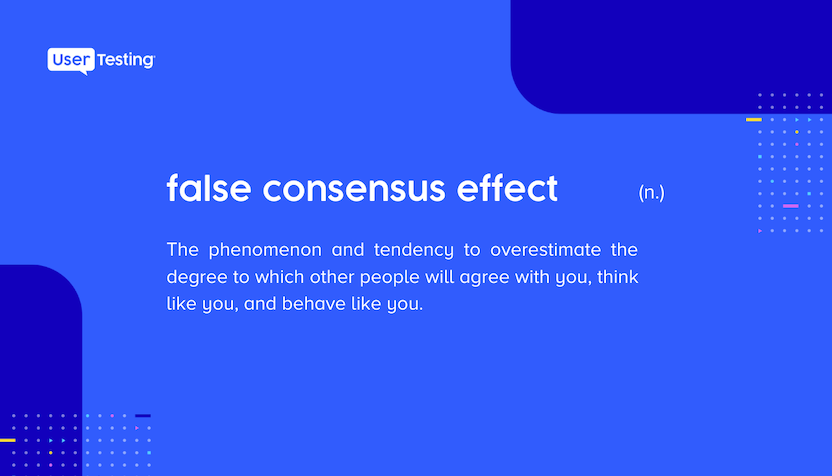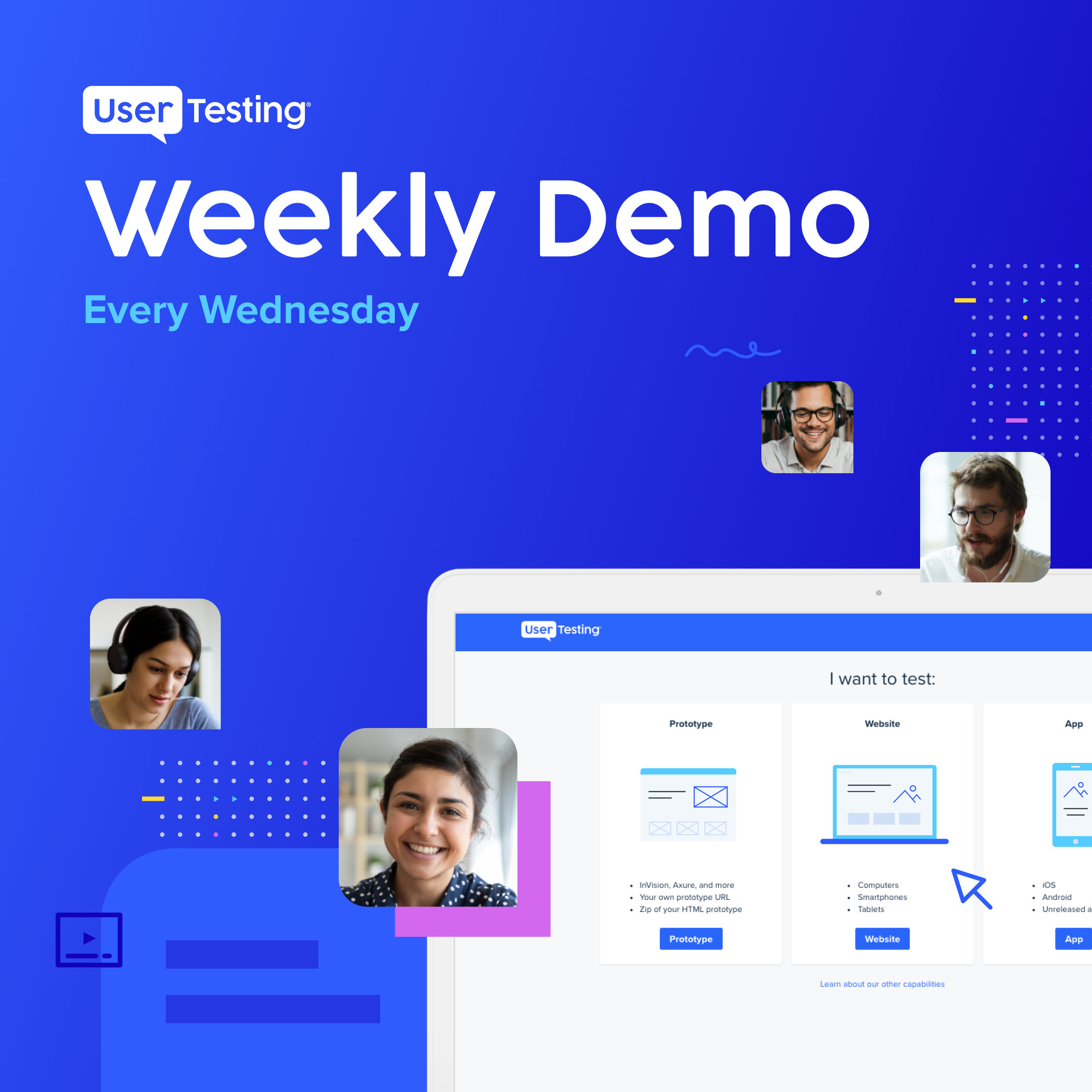
What is the false consensus effect in UX?

Everyone views the world through unique filters. Filters based on personal experiences, culture, environment, frame of mind—the list goes on. But often, these filters are shared, which sometimes causes people to believe that other people see the world in a similar way that they do. Enter: the false consensus effect.
What is the false consensus effect?
The false consensus effect is the phenomenon and tendency to overestimate the degree to which other people will agree with you, think like you, and behave like you.

Think of it like this. If you were asked to walk around your local college campus, place of work, or some other public space for 30 minutes wearing an “Eat at Joe’s” sign, would you do it?

In a study conducted at Stanford, 104 college students were asked this very same question. They were told they’re absolutely free to refuse if they wished, and here’s what happened:
- 62.2% of the people who agreed to wear the sign thought that others would also agree to wear it
- 67% of those who refused to wear the sign thought that others would also refuse to wear it
There was a majority in both cases. So what’s going on here? Without any additional context for answering the question, the students relied on the filters they have for perceiving the world around them in order to make their decision. It’s through their sense of the world that the students believed others would feel the same way. That’s the false consensus effect.
How the false consensus effect impacts business
It’s not entirely surprising that companies—including the most successful ones—fall prey to the false consensus effect. In fact, it’s probably where the popular user experience maxim comes from: you are not your user.
Think about all the times companies believe that they’ve come up with a breakthrough product or feature—one they believe their users will love as much as they do. Only to find out that after launch, the market doesn’t respond how they expect it to.
Typical users don’t think and behave the same way that you or people who work for your organization think they will. Which begs the question: how do you avoid falling victim to the false consensus effect?
How to avoid the false consensus effect
Building a new product or feature always comes with risk. This means you’re likely making important decisions based on limited information. And that requires you to make assumptions—either implicitly or explicitly.
There’s no way to avoid uncertainty completely, but you can reduce the probability of failure for your product by identifying the assumptions you’re making about what your intended users need—and then testing their validity before starting the expensive process of development.
“Leaping into the creation of a product on gut instinct alone, without doing research and rigorously putting your assumptions to the test, is the business equivalent of driving blindfolded.” -Jock Busuttil, instructor at General Assembly
Here are a few strategies to help you challenge your assumptions (and reduce risk) by collecting hard evidence to validate your product and design decisions.
1. Identify your assumptions
There are many ways to do this, but here’s one exercise you can do for free. Sit down with your most honest or cynical colleague or friend—preferably someone who works at a different company. You’ll also want to make sure it’s someone who you trust will tell you the truth instead of what they think you want to hear.Describe your product’s value proposition to them in as much detail as you can. Explain to them what your product offers, who it’s for, and why you think they’ll use it. Your friend’s job is to write down all the assumptions you’re making.
For each assumption they identify, you should ask yourself, “How do I know that x is true?” to verify whether or not you have supporting evidence to prove it. At the end of this exercise, you’ll have compiled a long list of assumptions.
The next step is to prioritize the riskiest assumptions that could potentially have the largest impact on your product—and to devise a set of experiments to put them to the test.
2. Conduct interviews with your target market
Now that you have a list of your most critical assumptions, it’s time to hold interviews with your intended users or buyers.
"Facts live outside the building, where future customers (prospects, really) live and work, so that's where you need to go." -Steve Blank
Set up as many hour-long interviews as you can—holding at least five. The purpose of these conversations is to deeply understand who these people are and to develop as much customer empathy as possible for what life is like for them. This is not the time to pitch your product or talk about your company. Your job is to ask questions, listen attentively, and digest what they have to say. Uncover:
- How they complete an activity or task today and what drives their decision-making process
- Opportunities for delight
- Needs or frustrations with an experience or activity
- Where and when they experience the problem you’re solving
- How they currently deal with the problem when it comes up
- How customers engage with competitive products
Each conversation gives you valuable customer insights into the problem you’re solving and who you’re solving it for. After a few conversations you’ll start to notice trends that will either confirm or challenge the picture you have of the target user of your product and what you think they want.
3. Continuously conduct remote usability testing
The final strategy for avoiding the false consensus effect is a technique known as remote usability testing—which is a method of remote research that uses an insight platform to record the screen (and voice, depending on the software you choose) of test participants as they interact with your product or experience in their natural environment—at home, in their office, or a specific location.
The purpose of testing your assumptions is to learn where you can make improvements. And continuous user testing will help you challenge your assumptions, build empathy for your users, and rapidly and incrementally iterate toward the right product to build.
The best part? You don’t need to write any code to start learning about your target market’s behaviors, habits, concerns, and preferences. In fact, the earlier you start getting feedback and making course corrections, the easier the product will be to change. Not to mention, it will greatly reduce wasted time and effort.
Start by sketching your design out on paper and testing that mockup with a few people, then move on to testing your wireframes and prototypes. By testing your product strategy with simpler prototypes before building an MVP, you’ll have validated so many of your hypotheses—and eliminated so many false assumptions—that you’ll be able to make product decisions based on hard evidence rather than what you think your users will like.
A final word on the false consensus effect
People have a natural tendency to overestimate the degree to which other people will agree with us, think like us, and behave like us. It’s your job to protect your team from falling victim to this bias—the false consensus effect.
Keep your focus on the users. The feedback you get from interviews and usability testing will give you a fresh perspective and help you discover what you need to iterate and improve—rather than building a product nobody wants or needs.
In this Article

Live weekly demo
Live weekly demo





